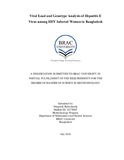Viral load and genotype analysis of Hepatitis E virus among HEV infected women in Bangladesh

View/
Date
2016-07Publisher
BRAC UniveristyAuthor
Rakhshanda, ShagoofaMetadata
Show full item recordAbstract
With an increase in the number of hepatitits E viral infected patients since the
identification of the virus in 1983, there is a rising concern in Bangladesh. A better
understanding of the virus at the genetic level can help further in the treatment of the
patients. Acute and chronic HEV infections can be much severe in pregnant women,
people with an underlying liver disease and immunocompromised and/or
immunosuppressed patients. The present study aimed at determining the viral load in
HEV positive patients at Dhaka, analyzing bioinformatically the genetic composition
of HEV to find any new substitution mutation and, with the aid of the level of liver
damage biomarkers found in the samples, predicting the effect and functional change
due to nucleic acid sequence variation on binding affinity of peptides to HLAs.
Although there was no significant differences in viral copy number among pregnant,
post-natal and non-pregnant women, the average copy numbers for the pregnant and
post-natal women were higher than that of the non-pregnant women (3360.84
copies/mL). At the 1592nd position in the nucleic acid sequence of three of the HEV
RNA positive patients, A and T substituted each other resulting in an amino acid
change at the 531st position, which was unlike those observed in other countries. The
substitution corresponded with the liver damage biomarkers and binding properties of
antigenic epitopes to the host cell receptor. These results may mend ways for further
analysis of such substitutions and can eventually help in understanding the virus, and
developing an appropriate treatment therapy.
